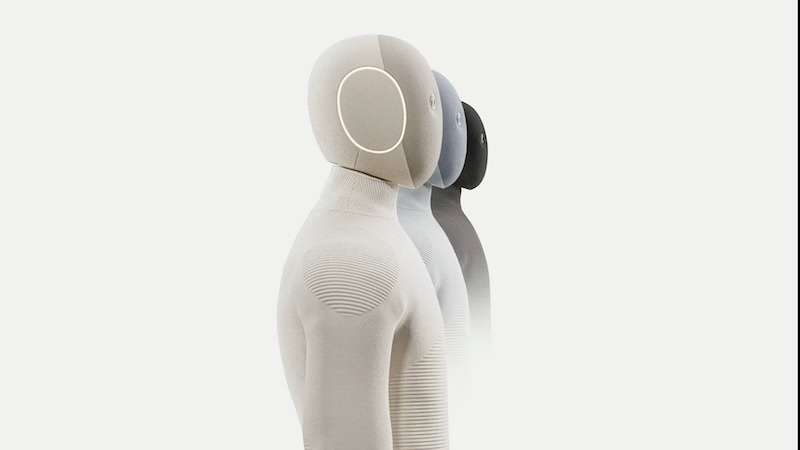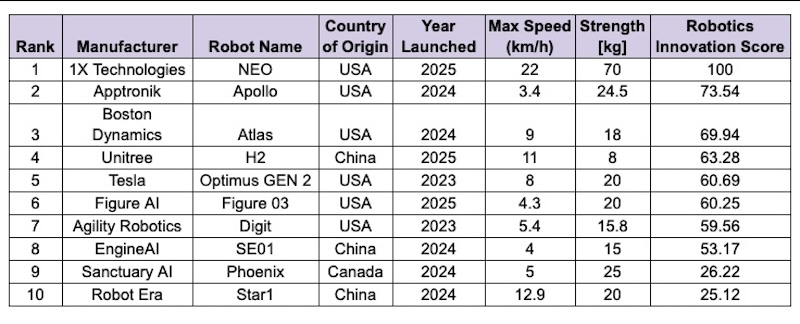Robots are reshaping industries, homes, and daily routines at an accelerating pace. From warehouse floors to living rooms, these machines are moving beyond repetitive tasks into roles that demand real-world adaptability and intelligence. But which robots truly represent the cutting edge of innovation?
Frans Tollenaar, CEO of Teqram, a provider of vision-guided robotic systems for industrial applications, explains: “The robotics industry has reached a turning point where we’re seeing humanoid and mobile robots that can navigate complex environments, manipulate objects with precision, and operate autonomously. These are no longer laboratory prototypes, but production models being deployed in real-world settings.”
To identify the most advanced robots currently operating, Teqram analyzed mobile, autonomous robots launched between 2020 and 2025.
The study evaluated each robot across five key performance factors:
- navigation;
- manipulation;
- degrees of freedom;
- speed; and
- strength.
Only robots capable of independent movement were included, excluding stationary communication-focused models.
‘World’s top 5 most advanced robots’
The full dataset includes a list of the top 15 “most advanced robots”, and is available on request from Teqram, along with the methodology.
1. NEO by 1X Technologies – Score: 100
NEO (main image) achieves “a perfect innovation score of 100”, according to this study, establishing itself as “the most advanced consumer-focused humanoid robot currently available”.
Designed specifically for home environments, NEO uses AI and tendon-driven actuation to handle household chores and provide personalized assistance.
The humanoid can fold laundry, organize shelves, and respond to voice commands, bringing what once seemed like science fiction into everyday living.
NEO’s technical specifications support its versatility. With a top speed of 22 km/h and strength capacity of 70 kg, it significantly outperforms competitors in mobility and lifting power.
The robot’s 75 degrees of freedom allow for fluid, natural movement that closely mimics human motion, making it capable of performing complex domestic tasks.
“NEO represents a major shift toward robots designed for everyday home environments,” says Tollenaar. “The combination of speed, strength, and articulation makes this a practical tool that can genuinely assist with daily tasks rather than serving as a novelty.”
2. Apollo by Apptronik – Score: 73.54
Apollo ranks second with a score of 73.54, positioning itself as a human-sized industrial humanoid built specifically for logistics and warehousing.
Standing approximately 5’8″ tall and weighing around 160 pounds, this humanoid is designed to operate safely alongside human workers, addressing labor shortages in industrial environments.
Apollo can lift up to 24.5 kg (approximately 55 pounds) and features 71 degrees of freedom that provide the dexterity needed for material handling tasks.
The humanoid’s maximum speed of 3.4 km/h reflects its design priorities. In warehouse settings where precision and safety matter more than speed, Apollo’s controlled movements allow it to work in close proximity to people without posing risks.
“Apollo addresses a real-world problem: labor shortages in warehousing,” notes Tollenaar. “Its human-scale design allows it to work in spaces built for people, without requiring facility redesigns.”
3. Atlas by Boston Dynamics – Score: 69.94
Atlas scores 69.94, maintaining its reputation as the world’s most dynamic humanoid robot. This fully electric humanoid is engineered for advanced mobility and manipulation, capable of walking, running, jumping, and using both hands to push the boundaries of what a robot body can do.
With a speed of 9 km/h, lifting capacity of 18 kg, and 50 degrees of freedom, Atlas demonstrates exceptional whole-body coordination.
The humanoid excels at both navigation and manipulation, scoring the maximum 3 rating in each category. This dual mastery makes Atlas exceptionally versatile, able to tackle tasks across different environments and applications.
“Atlas shows what’s possible when you prioritize dynamic movement,” Tollenaar explains. “Rather than optimizing for a single application, it demonstrates the full range of motion a humanoid body can achieve.”
4. Unitree H2 – Score: 63.28
China’s Unitree H2 ranks fourth with 63.28, presenting a full-sized humanoid robot that stands approximately 180 cm tall and weighs 70 kg.
The humanoid features 31 degrees of freedom that enable high agility and lifelike motion. Its advanced hands are designed for dexterous tasks, making the H2 suitable for versatile performance in both research and commercial applications.
The robot reaches speeds of 11 km/h while maintaining precise control. Though its strength rating of 8 kg is lower than top competitors, the H2’s sophisticated hand design and exceptional degree of freedom count, relative to its size, allow it to perform nuanced manipulation tasks that many stronger robots cannot.
5. Tesla Optimus GEN 2 – Score: 60.69
Tesla’s Optimus GEN 2 completes the top five with 60.69, representing a next-generation humanoid robot built for general-purpose work.
This humanoid combines advanced actuators with improved mobility, achieving a walking speed of 8 km/h. With a strength capacity of 20 kg, 22 degrees of freedom, and fingertip sensors for tactile feedback, Optimus GEN 2 is designed to handle repetitive, dangerous, or mundane tasks with increasing autonomy.
The humanoid represents Tesla’s ambition to bring robotics into manufacturing and eventually consumer markets at scale, focusing on practical applications where robots can take over tasks that are hazardous or tedious for human workers.
“What separates the top performers is their ability to combine multiple capabilities effectively,” Tollenaar observes. “Success comes from integrating navigation, manipulation, and autonomy into a system that can adapt to real-world unpredictability.”
Common thread
Frans Tollenaar, CEO of Teqram, says: “These rankings reveal how rapidly humanoid robotics is maturing from research projects into deployable systems.
“The top performers share a common thread: they balance technical specifications with real-world usability. High degrees of freedom matter, but only when paired with robust navigation and manipulation capabilities.”
“Looking ahead, we’re entering an era where humanoid robots will become commonplace in settings we never imagined a decade ago.
“Manufacturing floors will see more collaborative humanoid systems working alongside people. Homes may welcome humanoid assistants for daily tasks.
“The technology is reaching a point where the question shifts from ‘can robots do this?’ to ‘how do we integrate them responsibly?’ As these systems become more capable, the focus will turn to ensuring they’re safe, accessible, and genuinely beneficial to the people they’re designed to serve.”
Credit: Article contributed by Teqram, a supplier fully autonomous, vision-guided robotic systems. Sources include Humanoid.Guide.


